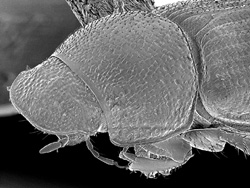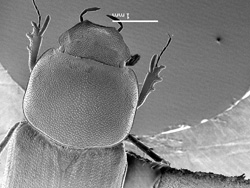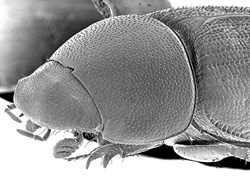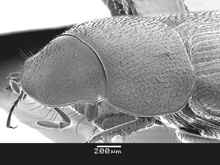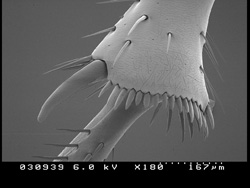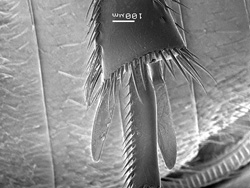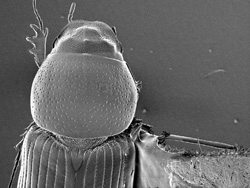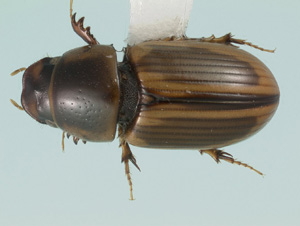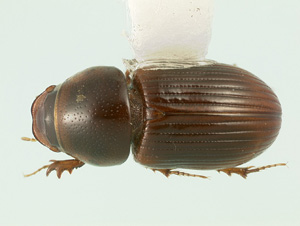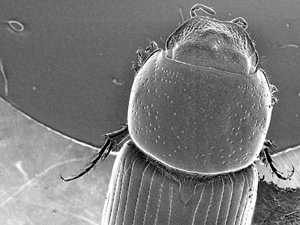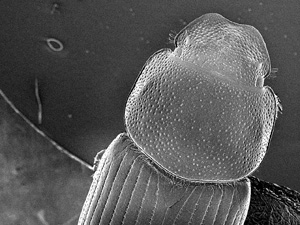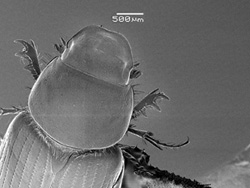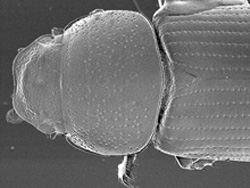|
|
| |
41(40).
.
.
|
Elytral disc distinctly and nearly entirely setose (Fig. 66); if setae indistinct, then surface strongly roughened and dulled. US and Canada |
.
.
42 |

Figure 66. |
41'.
.
.
.
|
Elytral disc lacking setae, or setae visible only on declivity and lateral margin; surface usually shiny, occasionally shiny between dense, coarse punctures. Widespread |
|
|
| |
|
| |
42(41).
.
.
.
|
Clypeal apex nearly truncate, lateral angles broadly rounded (Fig. 66); clypeal surface shiny, glabrous, punctures well separated. Pronotum black, elytron yellow and pale brown. North and Central America |
..
Melinopterus Mulsant (in part) |
| |
42'.
.
.
.
.
|
Clypeal apex emarginate, lateral angles broadly rounded to toothed (Fig. 67); clypeal surface usually densely punctate or granulate, setiferous or glabrous. Pronotum and elytron usually similar in color, black to dark brown |
|
|
|
|
Figure 66. Melinopterus femoralis. |
Figure 67. Setodius diogenes. |
|
| |
|
| |
43(42).
.
|
Elytral disc yellowish, black laterally and apically. northwestern North America |
Setodius Gordon and Skelley (in part) |
| |
43'.
.
|
Elytral disc color uniform or with vague darker markings on disc. Arizona or eastern US |
|
|
| |
|
| |
44(43).
.
.
|
Clypeal surface granulate (Fig. 68). Body dark brown. Southern Great Plains and southeastern North America |
Scabrostomus Gordon and Skelley (in part) |
| |
44'.
.
|
Clypeal surface smooth, punctures distinct (Fig. 69). Body usually black |
|
|
|
|
Figure 68. Scabrostomus baileyi. |
Figure 67. Lechorodius lutulentus. |
|
| |
|
| |
|
|
|
| |
46(45).
.
.
|
Head coarsely punctate, punctures impressed. Pronotal base distinctly margined at middle (Fig. 71). Southeastern North America |
Irrasinus
Gordon
and Skelley |
| |
46'.
.
.
|
Head finely punctate, punctures not impressed. Pronotal base lacking marginal line at middle (Fig. 72). Northeastern North America |
|
|
|
|
Figure 71. Irrasinus stupidus. |
Figure 72. Trichonotulus scrofa. |
|
| |
|
| |
47(41).
.
|
Meso- and metatibial apices fringed with short (Fig. 73), more or less equal spinules |
.
48 |
| |
47'.
.
.
.
.
|
Meso- and metatibial apices fringed with distinctly long and unequal spinules (Fig. 74), usually alternating long and short; apical spinules frequently worn or broken, if so, consider those on the transverse median carina of tibia |
|
|
|
|
Figure 73. Agoliinus anthracus. |
Figure 74. Cryptoscatomaseter haldemani. |
|
| |
|
| |
48(47).
.
.
|
Pronotum lacking basal marginal line (Fig. 75). Scutellum usually pentagonal, lateral margins parallel or convergent toward base |
.
.
49 |
| |
48'.
.
.
|
Pronotum with basal marginal line (Fig. 76). Scutellum triangular or pentagonal, lateral margins parallel or diverging toward base |
|
|
|
|
Figure 75. Nialaphodius nigrita. |
Figure 76. Oscarinus windsori. |
|
| |
|
| |
49(48).
.
.
|
Elytral striae deep apically, none shortened or joined preapically, all reaching apical margin (Fig. 77). Mexico |
.
Pharaphodius Reitter |
| |
49'.
.
|
Elytral striae deep or not, striae 7-10 variably shortened or joined preapically (Fig. 78). Widespread |
|
|
|
|
Figure 77. Pharaphodius oleosus. |
Figure 78. Oscarinus crassulus. |
|
| |
|
| |
50(49).
.
|
Elytron yellow, often with a more or less distinct brownish discal spot (Fig. 79). Widespread |
Labarrus
Mulsant and Rey |
| |
50'.
.
|
Elytron brown, reddish brown, or nearly black, without maculation (Fig. 80). Southeastern North America |
|
|
|
|
Figure 79. Labarrus pseudolividus. |
Figure 80. Nialaphodius nigrita. |
|
| |
|
| |
51(48).
.
.
.
|
Scutellum parallel or convergent toward base, frequently depressed below elytral surface (Fig. 81). Pronotal punctures widely scattered. Frontal tubercle present. Mexico and North America |
.
.
Calamosternus Motschulsky |
| |
51'.
.
.
.
|
Scutellum parallel or diverging toward base, usually triangular, not depressed below elytral surface (Fig. 82). Pronotal punctures evenly distributed, usually closely spaced. Frontal tubercle present or not |
|
|
|
|
Figure 81. Calamosternus granarius. |
Figure 82. Oscarinus rusicola. |
|
| |
|
| |
52(51).
.
|
Clypeus distinctly toothed or sharply angulate on each side (Fig. 83) |
.
53 |
| |
52'.
.
|
Clypeus rounded or weakly angulate on each side of middle (Fig. 84) |
|
|
|
|
Figure 83. Mendidius aculeatus. |
Figure 84. Pardalosus neodistinctus. |
|
| |
|
| |
53(52).
.
.
.
.
|
Body robust, entirely black. Lacking transverse clypeal ridge. Male parameres dorsoventrally flattened, lacking membranous appendages. Prairie states, southwestern and eastern North America, and Mexico |
.
.
.
Oscarinus Gordon and Skelley (in part) |
| |
53'.
.
.
.
.
|
Body more elongate, not robust, bicolored or pale, if black then with transverse clypeal ridge. Male parameres dorsoventrally flattened or not, often with membranous appendages. Northwestern and western North America |
|
|
| |
|
| |
54(53).
.
|
Clypeal apex quadridentate (Fig. 85). California and Oregon |
Maculaphodius Gordon and Skelley |
 Figure 85. Maculaphodius conspersus.
Figure 85. Maculaphodius conspersus. |
54'.
|
Clypeal apex bidentate |
|
|
| |
|
| |
55(54).
.
.
|
Small, length nearly 3 mm. Clypeus with angulation laterad of apical tooth (Fig. 86). California, Mexico
. |
Rugaphodius Gordon and Skelley (in part) |
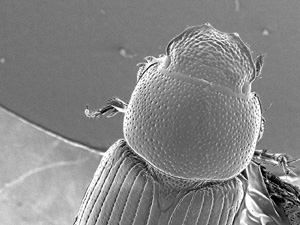 Figure 86. Rugaphodius rugatus.
Figure 86. Rugaphodius rugatus.
|
55'.
.
|
Larger, length 4 mm or more. Clypeus without angulation laterad of apical tooth |
|
|
| |
|
| |
56(55).
.
|
Body entirely pale brown. Male parameres lacking membranous lobes. Southwestern North America |
Mendidius
Harold |
| |
56'.
.
.
|
Body black, elytron red or with color pattern, rarely black. Male parameres with dorsal membranous appendage. Widespread, but not southeastern US |
|
|
| |
|
| |
57(52).
.
.
.
.
|
Clypeal apex weakly to distinctly emarginate medially (Fig. 87). Body 5 mm or longer, reddish brown or yellowish brown. Pronotum usually with fringe of long setae (lacking in B. obtusus). Western North America, southern South America |
.
.
.
.
58 |
| |
57'.
.
.
.
|
Clypeal apex distinctly emarginate medially (Fig. 88). Body length variable, color variably brown to dark brown. Pronotum usually lacking fringe of setae. Widespread |
|
|
|
|
Figure 87. Ballucus bruneaui. |
Figure 88. Pardalosus pardalis. |
|
| |
|
| |
|
| |
|
| |
59(57).
.
.
.
|
Pronotum wider than long, rectangular, weakly flattened (Fig. 89). Head and pronotal sides uniformly, densely punctate. Body color uniformly pale reddish brown. Southwestern North America |
.
Schaefferellus Gordon
and Skelley |
| |
59'.
.
.
.
|
Pronotum not rectangular, more robust (Fig. 90). Head and pronotal sides usually not uniformly, densely punctate. Body color usually dark, often with contrasting pattern |
|
|
|
|
Figure 89. Schaefferellus arizonenis. |
Figure 90. Oscarinus floridanus. |
|
| |
|
| |
60(59).
.
.
|
Pronotum, and usually elytron, fringed with long setae (Fig. 91). Body length 4 mm or less. Northwestern North America |
Setodius
Gordon and Skelley (in part) |
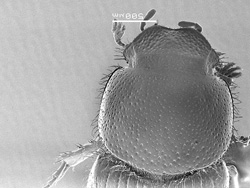 Figure 91. Setodius edmontonus.
Figure 91. Setodius edmontonus.
|
60'.
.
|
Pronotum and elytron not distinctly fringed with long setae. Body length variable, usually longer than 4 mm |
|
|



